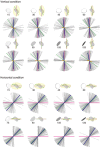Disambiguation of mental rotation by spatial frames of reference
- PMID: 23145239
- PMCID: PMC3485783
- DOI: 10.1068/i0425
Disambiguation of mental rotation by spatial frames of reference
Abstract
Previous research has shown that our ability to imagine object rotations is limited and associated with spatial reference frames; performance is poor unless the axis of rotation is aligned with the object-intrinsic frame or with the environmental frame. Here, we report an active effect of these reference frames on the process of mental rotation: they can disambiguate object rotations when the axis of rotation is ambiguous. Using novel mental rotation stimuli, in which the rotational axes between pairs of objects can be defined with respect to multiple frames of reference, we demonstrate that the vertical axis is preferentially used for imagined object rotations over the object-intrinsic axis for an efficient minimum rotation. In contrast, the object-intrinsic axis can play a decisive role when the vertical axis is absent as a way of resolving the ambiguity of rotational motion. When interpreted in conjunction with recent advances in the Bayesian framework for motion perception, our results suggest that these spatial frames of reference are incorporated into an internal model of object rotations, thereby shaping our ability to imagine the transformation of an object's spatial structure.
Keywords: internal model; mental rotation; reference frame.
Figures




Similar articles
-
The influence of spatial reference frames on imagined object- and viewer rotations.Acta Psychol (Amst). 1999 Sep;102(2-3):247-64. doi: 10.1016/s0001-6918(98)00057-2. Acta Psychol (Amst). 1999. PMID: 10504883 Review.
-
Viewer-external frames of reference in the mental transformation of 3-D objects.Percept Psychophys. 2005 Oct;67(7):1269-79. doi: 10.3758/bf03193558. Percept Psychophys. 2005. PMID: 16502847
-
Extrinsic reference frames modify the neural substrates of object-location representations.Neuropsychologia. 2013 Apr;51(5):781-8. doi: 10.1016/j.neuropsychologia.2013.02.004. Epub 2013 Feb 17. Neuropsychologia. 2013. PMID: 23422330
-
Mental rotation may underlie apparent object-based neglect.Neuropsychologia. 1996 Feb;34(2):113-26. doi: 10.1016/0028-3932(95)00088-7. Neuropsychologia. 1996. PMID: 8852874
-
Are All Spatial Reference Frames Egocentric? Reinterpreting Evidence for Allocentric, Object-Centered, or World-Centered Reference Frames.Front Hum Neurosci. 2015 Dec 9;9:648. doi: 10.3389/fnhum.2015.00648. eCollection 2015. Front Hum Neurosci. 2015. PMID: 26696861 Free PMC article. Review.
References
-
- Banerjee A, Dhillon I S, Ghosh J, Sra S. “Clustering on the unit hypersphere using von Mises-Fisher distributions”. Journal of Machine Learning Research. 2005;6:1345–1382.
-
- Biernacki C, Celeux G, Govaert G. “Assessing a mixture model for clustering with the integrated completed likelihood”. IEEE Transactions on Pattern Analysis and Machine Intelligence. 2000;22:719–725. doi: 10.1109/34.865189. - DOI
-
- Corballis M C, Zbrodoff J, Roldan C E. “What's up in mental rotation?”. Perception & Psychophysics. 1976;19:525–530. doi: 10.3758/BF03211221. - DOI
LinkOut - more resources
Full Text Sources

